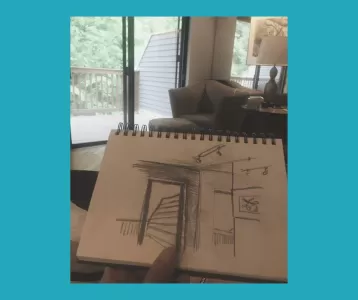Do we see ALL that is there to be seen?
Perspective in life can make all the difference. I have been enjoying my return to drawing. I am becoming bolder in selecting subjects. As you can see from the picture, I selected the corner of the room with a glass sliding door onto the deck and the adjacent mirrored wall. I wondered how I would do representing the mirrored image and was most fascinated with the outside privacy wall on the deck. Would I be able to capture the angle leading away from the building? I was pleased with this attempt.
I want you to consider another aspect of this brief anecdote. After reading the above paragraph, where does your focus go when looking at the picture? For most, you looked at the mirrored wall and the privacy wall. These are dominant features of this drawing so you would likely have noticed these on your own. Did you also look a little closer and consider the execution of this drawing? Maybe you noticed something else in the second visit. This is an example of how you or I can be led. Artists use visual tricks to catch your eye and encourage it to travel around and stay within the drawing.
Often those giving handmade gifts will frequently comment on a scratch or construction error they know exists which would otherwise have been ignored. Now you can’t pick up that gift without noticing the minor flaw. The giver unknowingly altered the receiver’s focus.
For those of us who are not enjoying our job, our attention is drawn toward what we don’t like. These will be the first thoughts that come to mind when someone asks how you are doing at work. These thoughts will also happen to be what we will share. Your friend thinks of what you don’t like, and coincidentally, you are reminded of what you don’t like. This grows and gains momentum in your mind undermining your mood. Our bodies absorb these feelings, and they can affect our appearance as well as our attitude. Feelings of dislike and unhappiness are carried as a burden. Whereas feelings of love and joy are weightless, like being injected with helium. We give off signs of our mood and relationship to our work physically. You don’t have to say a word about how miserable you are.
What is important in our jobs?
Our jobs, companies, and even ourselves change over time. This means work that began as being exciting and energizing might now feel burdensome. The cost of feeling this way shows up in our posture, facial expression, how we dress, and how we interact with our boss, colleagues, friends, family, and kids. Don’t fool yourself, you are not leaving it at the office. This will show up in your productivity and will influence your opportunities. It also becomes the example your children will have when they look for their jobs. The longer this is true the greater the impact the harder it may be to make a change, or the change might be made for you through being fired.
It is possible to use this focus on what we don’t like about our jobs as a focus for what needs attention. By seeing what we don’t like or isn’t working for us, we can use this attention to make positive adjustments that will remove the unwanted items or transform them into something more pleasant. Paying attention to what we are doing, how it is affecting us, will allow us to make these adjustments which will have our jobs contribute to our overall happiness. The adjustment could be uncovered in a brief conversation or through journaling. There are many tools that can assist you in identifying the issue and crafting a positive solution. Schedule a time for us to talk to see how you can transform the burden of work into a generator of energy for your life.









